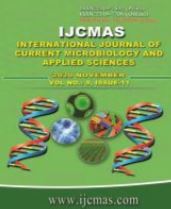


 National Academy of Agricultural Sciences (NAAS)
National Academy of Agricultural Sciences (NAAS)

|
PRINT ISSN : 2319-7692
Online ISSN : 2319-7706 Issues : 12 per year Publisher : Excellent Publishers Email : editorijcmas@gmail.com / submit@ijcmas.com Editor-in-chief: Dr.M.Prakash Index Copernicus ICV 2018: 95.39 NAAS RATING 2020: 5.38 |
The present study was conducted for assess the Economics of Marketing of Chickpea in Beed District of Maharashtra. Chickpea is one of the major pulse crops grown in India. Chickpea is grown in tropical, sub-tropical and temperate regions. Kabuli type is grown in temperate regions while the desi type chickpea is grown in the semi-arid tropics. Markets of chickpea in India are Delhi, Mumbai, Chennai, Hyderabad, Kanpur, Indore, Bikaner and Hapur. The multistage sampling design was used for selection of district, tehsils, villages and chickpea growers. In all 90 chickpea growers were selected to collect the data. The data were collected for the year 2018-19 and analyzed marketing cost, margin and price spread in marketing of chickpea was achieved through tabular analysis. Large quantity of production sold in channel-I (495.2 qt.) followed by channel-II (397.1 qt.) and channel-III (158.2 qt.). The total marketed surplus on chickpea farm was 11.67 q, out of which 5.50 q, 4.41 q and 1.75 q was marketed thought channel I, II, and III respectively. Total cost of chickpea incurred by village retailer was Rs.97.90 per quintal highest cost incurred by wholesaler was Rs.80.47 in channel-II followed by Rs.75.06 in channel-I. In channel-I price spread was 698.79 followed by 343.11 in channel-II and 41.13 in channel-III.
 |
 |
 |
 |
 |